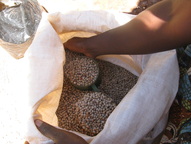
 For the annual party of Nane Nane, the August 8th 2014 (National Agriculture Exhibition), the director of KIHO, Mr. Kateri Genes Daniel and the European volunteer, Mr. Jerome Alain Faes went to Arusha accompanied with five local farmers from Same district, who aimed at visiting Nane Nane National Agriculture Exhibition to discover the novelties regarding agriculture and relative appropriate technologies.
0 Comments
 Application of Money Maker Pumps to improve small scale irrigation systems by farmers themselves: Thanks to financial and material support of United Nations - World Food Program and hard work of the team of Kilimanjaro Hope Organization (KIHO). On Wednesday, 23 and Thursday, July 24th 2014; the Kilimanjaro Hope Organization had a pleasure to be able to supply 7 manual pumps to farmers of Minyala village. On Wednesday 23rd, the three development initiative groups namely, Miu Mwera Group, Mwamko Group and Kilimo Hai Group, each received a complete set of the Money Maker Pump.  3 languages were spoken: Maasai, Swahili and English 3 languages were spoken: Maasai, Swahili and English Last Thursday KIHO attended a sub-village meeting at Bagamoyo Maasai community, located in the Terite area, near Ruvu village, Same District. The meeting focused on the severe water scarcity currently faced by the Maasai community of this area which includes 27 sub-villages (the so-called “bomas”), for an estimated total of 700-1,000 people (the number is not accurate, as the Maasai are a nomadic tribe: men are mainly shepherds or cattle-keepers and most of them come back home during the rainy season only).  Pipe water furrow digging in Chajo Pipe water furrow digging in Chajo As a local cooperating partner of the United Nations World Food Program (WFP), KIHO is constantly coordinating and monitoring its 2013/2014 “Food For Asset Creation” (FFA) projects. Construction works in all the six villages of Same District in Kilimanjaro Region involved began in August/September 2013, are now halfway and are expected to be concluded within March 2014. The six “Food for Asset Creation” projects are: four gravity water projects in Chajo, Gonjanza, Malindi and Mwembe and two market access road constructions in Tae-Mongoloma and Minyala-Matongo. Globally, 970 households are involved, respectively: 169 in Chajo, 165 in Gonjanza, 165 in Malindi, 169 in Mwembe, 177 in Tae-Mongoloma and 125 in Minyala-Matongo, corresponding to an estimated total of 18,169 people.  KIHO is proud to announce that the United Nations World Food Program (WFP) has awarded us (KIHO) as a local cooperating partner for the second time in a row. Six out of nine project proposals that we submitted in May 2013 to WFP have been approved for the implementation in the financial year 2013/2014. These “Food for Asset Creation” projects include four gravity water projects in Chajo, Gonjanza, Malindi and Mwembe as well as two market access road constructions in Tae-Mongoloma and Minyala-Matongo.  On Monday, KIHO visited some rural women in Kirinjiko, a sub-village of Chajo. It is a 15 minutes drive from Same town along the tarmac road to Dar es Salaam and the sub-village consists of some 70 households. In earlier times, the women sold charcoal to people-passing by in their vehicles on this busy road. However, all the big trees in the area have been cut down in the meantime, bringing the charcoal-making business to a halt. Today, the women rely on selling firewood. However, around their area even the smaller trees have been cut down.  Today we have submitted a project proposal for the “U.S. Ambassador’s Special Self-Help Fund” which is organized by the U.S. embassy in Dar es Salaam. It is only a grant of $5,000 (an equivalent to TSH 8 million), but it could change the live of smallholder farmers in the Pare mountains. The project is to restore and upgrade a water irrigation pond in Mhero village located close to Shengena Forest. An initiative from Mhero approached a KIHO delegation during a visit in early February 2013, and stressed that one of their main needs are the restoration of water irrigation ponds to allow farming throughout the year and combat food insecurity.  On Saturday, a KIHO delegation returned from a four-day trip to different villages in Ruvu ward, located next to Pangani river basin. The area is in the lowlands in the extreme west of Same district and it is indeed very hot and dry there. Nonetheless, there is a lot of farming going on in the meantime thanks to water irrigation canals that has made the land very fertile. However, there is conflict and tension between cattle-keepers and farmers in the area. Both groups depend on water from the Pangani river (or the irrigation canals). |
News UpdatesOn this page you can find news updates about KIHO. Please feel free to comment. Archives
November 2014
Categories
All
|
 RSS Feed
RSS Feed
